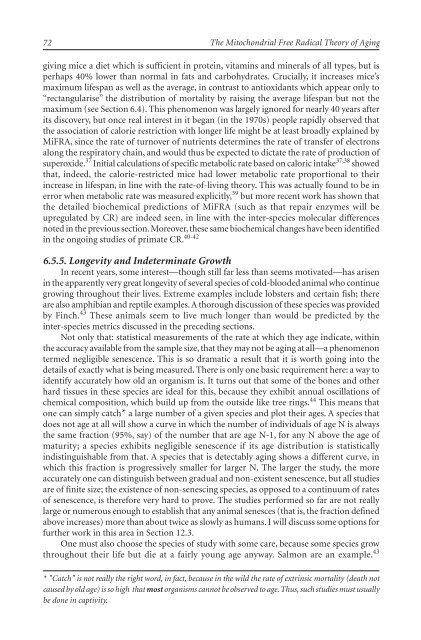The Mitochondrial Free Radical Theory of Aging - Supernova: Pliki
The Mitochondrial Free Radical Theory of Aging - Supernova: Pliki
The Mitochondrial Free Radical Theory of Aging - Supernova: Pliki
You also want an ePaper? Increase the reach of your titles
YUMPU automatically turns print PDFs into web optimized ePapers that Google loves.
72<br />
<strong>The</strong> <strong>Mitochondrial</strong> <strong>Free</strong> <strong>Radical</strong> <strong>The</strong>ory <strong>of</strong> <strong>Aging</strong><br />
giving mice a diet which is sufficient in protein, vitamins and minerals <strong>of</strong> all types, but is<br />
perhaps 40% lower than normal in fats and carbohydrates. Crucially, it increases mice’s<br />
maximum lifespan as well as the average, in contrast to antioxidants which appear only to<br />
“rectangularise” the distribution <strong>of</strong> mortality by raising the average lifespan but not the<br />
maximum (see Section 6.4). This phenomenon was largely ignored for nearly 40 years after<br />
its discovery, but once real interest in it began (in the 1970s) people rapidly observed that<br />
the association <strong>of</strong> calorie restriction with longer life might be at least broadly explained by<br />
MiFRA, since the rate <strong>of</strong> turnover <strong>of</strong> nutrients determines the rate <strong>of</strong> transfer <strong>of</strong> electrons<br />
along the respiratory chain, and would thus be expected to dictate the rate <strong>of</strong> production <strong>of</strong><br />
superoxide. 37 Initial calculations <strong>of</strong> specific metabolic rate based on caloric intake 37,38 showed<br />
that, indeed, the calorie-restricted mice had lower metabolic rate proportional to their<br />
increase in lifespan, in line with the rate-<strong>of</strong>-living theory. This was actually found to be in<br />
error when metabolic rate was measured explicitly, 39 but more recent work has shown that<br />
the detailed biochemical predictions <strong>of</strong> MiFRA (such as that repair enzymes will be<br />
upregulated by CR) are indeed seen, in line with the inter-species molecular differences<br />
noted in the previous section. Moreover, these same biochemical changes have been identified<br />
in the ongoing studies <strong>of</strong> primate CR. 40-42<br />
6.5.5. Longevity and Indeterminate Growth<br />
In recent years, some interest—though still far less than seems motivated—has arisen<br />
in the apparently very great longevity <strong>of</strong> several species <strong>of</strong> cold-blooded animal who continue<br />
growing throughout their lives. Extreme examples include lobsters and certain fish; there<br />
are also amphibian and reptile examples. A thorough discussion <strong>of</strong> these species was provided<br />
by Finch. 43 <strong>The</strong>se animals seem to live much longer than would be predicted by the<br />
inter-species metrics discussed in the preceding sections.<br />
Not only that: statistical measurements <strong>of</strong> the rate at which they age indicate, within<br />
the accuracy available from the sample size, that they may not be aging at all—a phenomenon<br />
termed negligible senescence. This is so dramatic a result that it is worth going into the<br />
details <strong>of</strong> exactly what is being measured. <strong>The</strong>re is only one basic requirement here: a way to<br />
identify accurately how old an organism is. It turns out that some <strong>of</strong> the bones and other<br />
hard tissues in these species are ideal for this, because they exhibit annual oscillations <strong>of</strong><br />
chemical composition, which build up from the outside like tree rings. 44 This means that<br />
one can simply catch* a large number <strong>of</strong> a given species and plot their ages. A species that<br />
does not age at all will show a curve in which the number <strong>of</strong> individuals <strong>of</strong> age N is always<br />
the same fraction (95%, say) <strong>of</strong> the number that are age N-1, for any N above the age <strong>of</strong><br />
maturity; a species exhibits negligible senescence if its age distribution is statistically<br />
indistinguishable from that. A species that is detectably aging shows a different curve, in<br />
which this fraction is progressively smaller for larger N. <strong>The</strong> larger the study, the more<br />
accurately one can distinguish between gradual and non-existent senescence, but all studies<br />
are <strong>of</strong> finite size; the existence <strong>of</strong> non-senescing species, as opposed to a continuum <strong>of</strong> rates<br />
<strong>of</strong> senescence, is therefore very hard to prove. <strong>The</strong> studies performed so far are not really<br />
large or numerous enough to establish that any animal senesces (that is, the fraction defined<br />
above increases) more than about twice as slowly as humans. I will discuss some options for<br />
further work in this area in Section 12.3.<br />
One must also choose the species <strong>of</strong> study with some care, because some species grow<br />
throughout their life but die at a fairly young age anyway. Salmon are an example. 43<br />
* "Catch" is not really the right word, in fact, because in the wild the rate <strong>of</strong> extrinsic mortality (death not<br />
caused by old age) is so high that most organisms cannot be observed to age. Thus, such studies must usually<br />
be done in captivity.


